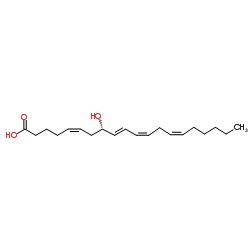Differential activation of peroxisome proliferator-activated receptors by eicosanoids.
K Yu, W Bayona, C B Kallen, H P Harding, C P Ravera, G McMahon, M Brown, M A Lazar
Index: J. Biol. Chem. 270 , 23975-23983, (1995)
Full Text: HTML
Abstract
Peroxisome proliferator-activated receptors (PPARs) are nuclear hormone receptors that regulate gene transcription in response to peroxisome proliferators and fatty acids. PPARs also play an important role in the regulation of adipocyte differentiation. It is unclear, however, what naturally occurring compounds activate each of the PPAR subtypes. To address this issue, a screening assay was established using heterologous fusions of the bacterial tetracycline repressor to several members of the peroxisome proliferator-activated receptor (PPAR) family. This assay was employed to compare the activation of PPAR family members by known PPAR activators including peroxisome proliferators and fatty acids. Interestingly, the activation of PPARs by fatty acids was partially inhibited by the cyclooxygenase inhibitor indomethacin, which prevents prostaglandin synthesis. Indeed, prostaglandins PGA1 and 2, PGD1 and 2, and PGJ2-activated PPARs, while a number of other prostaglandins had no effect. We also screened a variety of hydroxyeicosatetraenoic acids (HETEs) for the ability to activate PPARs. 8(S)-HETE, but not other (S)-HETEs, was a strong activator of PPAR alpha. Remarkably, PPAR activation by 8(S)-HETE was stereoselective. In addition, 8(S)-HETE was able to induce differentiation of 3T3-L1 preadipocytes. These results indicate that PPARs are differentially activated by naturally occurring eicosanoids and related molecules.
Related Compounds
| Structure | Name/CAS No. | Molecular Formula | Articles |
|---|---|---|---|
 |
8(s)-hete
CAS:98462-03-4 |
C20H32O3 |
|
HMDB: a knowledgebase for the human metabolome.
2009-01-01 [Nucleic Acids Res. 37(Database issue) , D603-10, (2009)] |
|
The human serum metabolome.
2011-01-01 [PLoS ONE 6(2) , e16957, (2011)] |
|
Lipidomics reveals a remarkable diversity of lipids in human...
2010-11-01 [J. Lipid Res. 51(11) , 3299-305, (2010)] |
|
Simultaneous quantification of leukotrienes and hydroxyeicos...
2015-07-01 [Biomed. Chromatogr. 29 , 1084-93, (2015)] |
|
A targeted lipidomics approach to the study of eicosanoid re...
2011-01-01 [Arthritis. Res. Ther. 13 , R123, (2011)] |